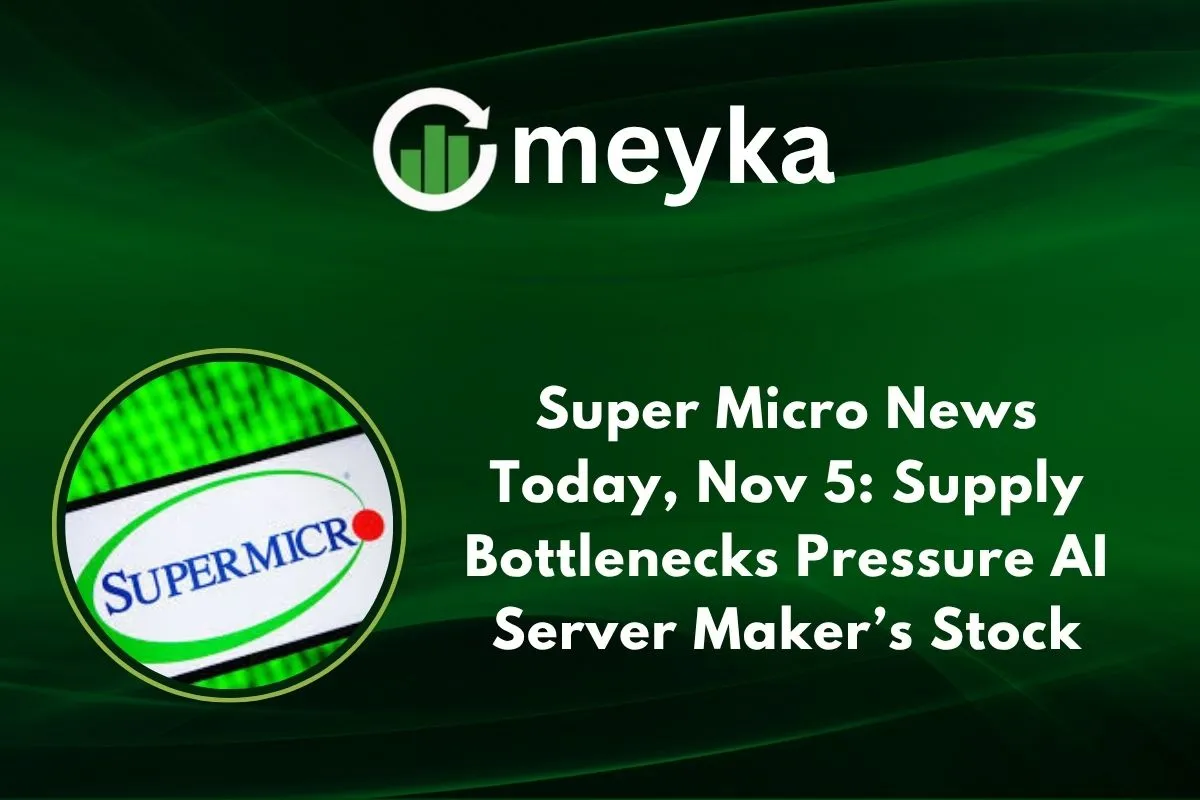Super Micro News Today, Nov 5: Supply Bottlenecks Pressure AI Server Maker’s Stock
We’re watching a critical moment for Super Micro. The company, once a clear beneficiary of the AI server boom, just announced that about US$1.5 billion of expected revenue in the quarter has been shifted out due to delivery delays. Its shares dropped over 8‑9% as investors responded to the news. In short, even in a hot growth market like AI infrastructure, execution matters just as much as innovation. In what follows, we’ll unpack Super Micro’s position, the bottlenecks it faces, the financial fallout, the root causes, and what we as investors (or observers) should keep an eye on.
Company background & market context
Super Micro Computer is based in San Jose, California, and makes high‑performance servers aimed at data centres, cloud providers, AI workloads, and edge computing. The company has carved out a solid niche: its systems are often built around the latest GPUs (graphics processing units) and are designed for the intensive workloads of generative AI.
Through 2024‑25, the broader AI‑server market has grown very fast. Major tech firms are investing heavily in infrastructure. Super Micro rode this trend, and investors saw it as one of the “AI server pure plays”. However, the environment is increasingly competitive. Large players like Dell Technologies, Hewlett-Packard Enterprise have beefed up their AI server offerings.
This means that Super Micro’s high growth narrative comes with higher expectations and higher risk.
These supply bottlenecks
Recently, Super Micro announced that it missed estimates for the quarter. It blamed the shortfall on “design win upgrades”, large‐volume AI server orders where configuration changes delayed deliveries. Specifically, about US$1.5 billion of revenue that was expected in the September quarter was moved to the December quarter.
What caused the shift? The company cited the complexity of new GPU‑rack systems, which require extensive integration, testing, and validation. What this means in practice: even though demand is strong, execution delays are reducing near‑term revenue and shaking investor confidence.
Financial and stock impact
Because of the delays, Super Micro’s shares reacted sharply. They fell more than 8% in extended trading when the news broke. The company posted first‑quarter revenue of about US$5 billion, missing the analyst consensus of around US$6 billion. On the positive side, Super Micro raised its full‑year revenue forecast, now expecting at least US$36 billion (up from US$33 billion). It also forecast second‑quarter revenue in the US$10‑11 billion range, well above Wall Street’s ~US$7.83 billion estimate. Still, the near‐term miss shows that growth without flawless execution can sour sentiment. For investors, the message is: strong demand is helpful, but if you miss delivery, the market penalises you quickly.
Why the bottlenecks? Root causes
Let’s examine the causes:
- Product complexity: The new GPU racks (e.g., built for the latest chip architecture from NVIDIA Corporation) demand intricate design, cooling, blending of multiple components, and validation. This naturally slows delivery when volumes and technical specs rise.
- Lead‑time pressures: As AI demand surges, components such as GPUs, cooling modules are in high demand, making supply chains tighter. The delays amplify when you combine high volume + custom configuration.
- Customer timing: Some large hyperscalers may delay decisions or request upgrades, which shifts revenue allocation and timing. For example, Super Micro said large orders were shifted because a high‑volume customer requested changes.
- Competitive/margin trade‑offs: To win large AI deals, Super Micro may be offering aggressive pricing or accepting configuration complexity that pressures margins and execution. Analysts have flagged that margin compression is a risk.
All of these combine to increase execution risk: you may have the demand, but delivering on time and on budget becomes the harder part.
Broader implications
What does this mean beyond the numbers?
- For Super Micro: The company remains a strong player in the AI‑server market. But it must now show it can scale reliably, deliver to schedule, maintain margins, and manage customer complexity. Execution will define share appreciation from here.
- For the AI infrastructure segment: The episode highlights that even in a “hot” market, companies can stumble if they don’t manage supply chain and configuration complexity. That means perhaps the market for AI servers is less straightforward than merely “demand skyrockets.”
- For investors: There is significant upside in Super Micro (given the AI tailwinds), but also significant risk (execution, competition, margin pressure). We must weigh both sides.
- For customers/partners: If major players face delivery delays, that could raise costs, push out AI deployments, or shift business to competitors. That means flexibility and contingency may be more important than ever for hyperscalers and cloud providers.
Outlook & key metrics to watch
What should we monitor in the coming quarters?
- Delivery timing: Does Super Micro actually convert the US$1.5 billion revenue shift into the December quarter as planned? Delays beyond that would raise concern.
- Margin trends: With higher volume comes risk of margin erosion. If Super Micro keeps sacrificing margin for volume, profitability could suffer.
- Order backlog vs fulfillment: Are orders building up? Are they being delivered? A huge backlog is a good sign of demand, but if it turns into an unfulfilled backlog, that’s a warning.
- Competition moves: If Dell, HPE, or other OEMs poach Super Micro’s prospective customers, the share gain narrative could weaken.
- Supply chain constraints: Any new announcements of constraints in GPUs, cooling, or bottlenecks will matter.
- Regulatory/financial reporting: Past issues (governance, controls) have haunted Super Micro. Any new issues could erode confidence.
If Super Micro executes well on these fronts, the long‑term growth story remains intact. If it falters, near‑term volatility could continue.
Conclusion
To sum up: Super Micro is at an important inflection point. The company sits in the middle of a major secular trend, AI infrastructure, and has the assets, product offerings, and partnerships to win. But the recent revenue shift and delivery delays signal that the growth story is only half the battle. Execution will decide the rest. We must remain cautiously optimistic: the upside is large, but the execution risk is real. For investors and industry watchers alike, the question is no longer if demand for AI servers will stay strong, but which companies can deliver them at scale, on time, and with healthy margins. Super Micro has the chance; now it must prove it.
FAQS
Yes. Super Micro makes high‑performance servers and racks for AI workloads and data centers. These systems use advanced chips from companies like NVIDIA Corporation, which power generative‑AI models.
Supermicro builds server systems for cloud providers, big data centers, and edge computing. Their technology helps companies run AI, storage, and high‑performance computing tasks at scale.
The stock slid because the company missed revenue estimates and cited delivery and execution problems. It also faces tough competition and margin pressure in the AI‐server market.
Disclaimer:
The content shared by Meyka AI PTY LTD is solely for research and informational purposes. Meyka is not a financial advisory service, and the information provided should not be considered investment or trading advice.






